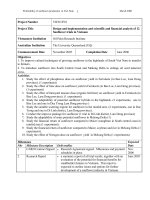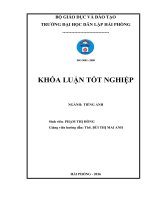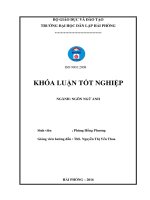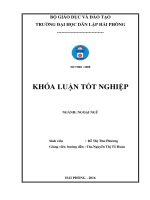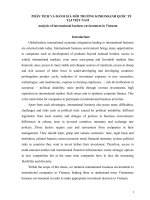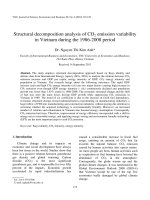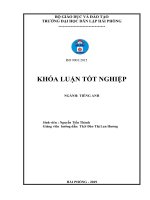Analysis of genetic diversity of local pigmented rice in vietnam (khóa luận tốt nghiệp)
Bạn đang xem bản rút gọn của tài liệu. Xem và tải ngay bản đầy đủ của tài liệu tại đây (1.4 MB, 51 trang )
VIETNAM NATIONAL UNIVERSITY OF AGRICULTURE
FACULTY OF BIOTECHNOLOGY
UNERGRADUATE THESIS
ANALYSIS OF GENETIC DIVERSITY OF LOCAL
PIGMENTED RICE IN VIETNAM
Student
:
NGUYEN VU KIEU OANH
Supervivor
:
LE DUC THAO, Ph.D
MSc. NGUYEN QUOC CHUNG
ID
:
614076
Class
:
K61CNSHE
Hanoi - 2021
ACKNOWLEDGEMENTS
Firstly, I would like to express my appreciation to the directory of the
Vietnam National University of Agriculture, the board of deans, and lectures in
the faculty of biotechnology that created the best condition for me to perform
and complete my thesis.
Secondly, I’m deeply indebted to my supervisors, Dr. Le Duc Thao and
MSc. Nguyen Quoc Trung, who guided me to conduct experiments and advised
me on professional knowledge. Their support gave me knowledge and patience
to accomplish the thesis.
I would also like to thank guides from Crop Research and Development
Institute who shared useful experiences in building field layout and rice
cultivation for me.
I gratefully acknowledge my colleagues in the laboratory for their
wonderful assistance. Thank to them, I can complete my research with high
excitement.
Last but not least, I would like to thank my parents for their support in the
study as well as in life. I have never finished my dissertation without their love
and their support. I sincerely thank all of you!
Hanoi ………………
Student
Nguyen Vu Kieu Oanh
i
COMMITMENT
I guarantee that this thesis is my original works and all the data and
results in this thesis are truthful and have never been used in any report yet.
I also assure that the information cited in the thesis is indicated the origin
and all the help is thankful.
Hanoi ………………
Student
Nguyen Vu Kieu Oanh
ii
LIST OF CONTENTS
Acknowledgements ................................................................................................ i
COMMITMENT ................................................................................................... ii
LIST OF contents.................................................................................................iii
LIST OF TABLES ................................................................................................ v
LIST OF FIGURES ............................................................................................. vi
SUMMARY ........................................................................................................ vii
CHAPTER 1. INTRODUCTION ......................................................................... 1
1.1. Introduction .................................................................................................... 1
1.1.2.Objectives .................................................................................................... 2
1.1.3. Requirements .............................................................................................. 2
CHAPTER 2. LITERATURE REVIEW .............................................................. 3
2.1. Genetic resources of rice................................................................................ 3
2.1.1. Genetic resources ........................................................................................ 3
2.1.2. Global genetic resources of rice ................................................................. 3
2.1.3. Genetic resources of rice in Vietnam.......................................................... 6
2.1.4. Pigmented rice genetic resources................................................................ 6
2.2. Pigmented rice ............................................................................................... 7
2.2.1. Properties of pigmented rice ....................................................................... 7
2.2.2. Anthocyanin ................................................................................................ 9
2.2.3. The studies about genetic diversity of rice. .............................................. 14
Chapter 3. Materials and methods. ..................................................................... 16
3.1. Materials ...................................................................................................... 16
3.2. METHODS .................................................................................................. 19
3.2.1. Field layout ............................................................................................... 19
3.2.2. DNA extraction with potasium acetate (CH3COOK). .............................. 20
3.2.3. PCR reaction: ............................................................................................ 20
3.2.4. Electrophoresis:......................................................................................... 21
3.2.5. Data processing. ........................................................................................ 21
iii
3.2.6. Anthocyanin content measurement........................................................... 22
Chapter 4. Results and discussions ..................................................................... 24
4.1. The result of the DNA extraction of 30 accessions. .................................... 24
4.3. Analysis the genetic relationships between the studied pigmented rice
samples. .................................................................................................... 27
4.3. Total anthocyanin content ............................................................................ 28
CHAPTER 5. CONCLUSIONS AND SUGGESTIONS ................................... 32
5.1. Conclusions .................................................................................................. 32
5.2. Suggestions .................................................................................................. 32
REFERENTS ...................................................................................................... 34
APPENDIX ......................................................................................................... 42
iv
LIST OF TABLES
Table 1. Several anthocyanins in pigmented rice (Deng et al., 2013) ................ 12
Table 2. 35 SSR molecular markers were used in the experiment. .................... 16
Table 3. 30 pigmented rice varieties was used in this research .......................... 17
Table 4. The compositions of PCR ..................................................................... 21
Table 5. the PIC index of 3 SSR markers ........................................................... 24
Table 6. Total anthocyanin content of 30 accessions. ....................................... 28
Table 7. Classification of 30 accessions by anthocyanin content. ..................... 29
Table 8. Classification of color of rice pericarp. ................................................ 31
v
LIST OF FIGURES
Figure 1. Black rice, Red rice and other pigmented rice varieties. ...................... 8
Figure 2. The Basic structur of Anthocyanin (Athanasios Valavanidis et
al, Studies in Natural Products Chemistry, 2013) .................................... 10
Figure 3. Chemical diagram of color-changing anthocyanin pH reaction
Under different pH conditions(Kan, Vargo et al. 2017) .......................... 11
Figure 4. The field layout ................................................................................... 19
Figure 5. The extraction anthocyanin content in rice. ........................................ 22
Figure 6. The test results the quality of DNA on Agarose 1% gel. .................... 24
Figure 7. Electrophoresis images of several SSR pairs of primers .................... 26
Figure 8. The dendrogram of the genetic similarity coefficients Jaccard of
30 pigmented rice varieties ....................................................................... 28
Figure 9. Total anthocyanin content (mg/100g) of 30 accessions. ..................... 29
Figure 10. color of pericarp of 30 accessions. .................................................... 30
vi
SUMMARY
The experiment aimed to analyze the genetic diversity of 30 local
pigmented rice accessions based on the presence and polymorphism level of
SSR molecular markers. The experiment used 35 SSR molecular markers with a
total of 47 alleles, 20 markers present polymorphism, an average of 2.04 alleles
per locus. Polymorphic Information Content (PIC) ranged from 0.00 to 0.99
with an average value of 0.27. The rice cultivars were divided into 2 main
groups. In addition, experiments also determined the anthocyanin content of
varieties. Two varieties with the highest anthocyanin content were C6 and C22
with concentration 92.3 mg/100g.. The data obtained in this study would
provide important information for the breeding of hight quality rice accessions
by molecular markers.
vii
CHAPTER 1. INTRODUCTION
1.1. Introduction
Rice (Oryza sativa) makes a major contribution to the calorific intake of
populations in countries where rice is the main food source. However, white
rice is a poor source of vitamins and minerals, Therefore, the diet is too
dependent on it is a risk of the lack of some nutritional factors (Dipti, Bergman
et al. 2012) (Muthayya, Sugimoto et al. 2014). Some studies report that the
nutritional quality of white rice is poor ycompared to that of pigmented
variants(Mbanjo, Kretzschmar et al. 2020). Today, the increasing consumer
interest in health-promoting food products is creating a significant market for
rice with higher nutritional value, creating health benefits for large numbers of
people. However, the high market demand of humans for white rice leading to
the depletion of pigmented varieties (Ahuja, Ahuja et al. 2007). Currently, most
pigmented rice varieties are low-yielding, being grown only for local markets
(Mbanjo, Jones et al. 2019).
The pigmented (black, purple, red-orange, or brown) rice have the
compounds responsible for these color variations like flavonoids, anthocyanin,
and proanthocyanidin in their pericarps. Black and purple pericarps are the
results of the accumulation of anthocyanin, while red pericarps are due to
proanthocyanidins (Gunaratne, Wu et al. 2013, Samyor, Das et al. 2017). These
compounds also have lots of nutritional value (Mbanjo, Kretzschmar et al.
2020). Vietnam is a country with very diverse rice genetic resources especially
pigmented rice gene resources. Most pigmented rice varieties are specialty rice
varieties that have been grown for a long time and are used for many different
purposes in the lives of Vietnamese people. The products made from it are
present at vast of majority festivals and it creates civilization bearing national
cultural identity. Pigmented rice is grown in many localities, different
ecological regions, and is diverse in style and color. However, in Vietnam,
there are only a few studies on the genetic diversity of local pigmented rice.
1
This leads to difficulties in the conservation of the diversity of this pigmented
rice gene resource. Therefore, the study of the genetic diversity of pigmented
rice is not only meaningful in providing information on genetic resources,
selecting materials for high-quality rice breeding in Vietnam but also has
significance in the conservation of local pigmented rice varieties.
Plant varieties in general and rice varieties, in particular, have different
genetic structures, which is a good source of materials to guide the breeding and
selection of new rice varieties. The evaluation of genetic diversity can be based
on phenotype or genotype (using molecular markers). Using molecular markers
is a powerful tool in assessing genetic variation, explaining genetic relationships
within and between species. The advantage of this type of evaluation is fast,
accurate, for high and stable polymorphism. Assessing genetic diversity by
molecular markers provides more information and accuracy than morphological
methods. The biggest advantage of this method is to detect DNA level
differences and save time as studies can be conducted early when rice is still in
the seedling stage.
1.1.2.Objectives
In this study, we analyze the genetic diversity of 30 newly collected local
pigmented rice varieties in Vietnam by DNA markers. Results of the research
will be used for conservation, providing information on genetic resources, and
exploiting high-yield and good quality rice varieties.
1.1.3. Requirements
- Extraction of DNA from leaf samples of 30 pigmented rice varieties,
PCR with SSR markers, and electrophoresis.
- Analysis of genetic diversity by constructing phylogenetic tree( use
program NTSYS 2-1) and using Polymorphism Information Content (PIC).
- Determination of the anthocyanin content.
2
CHAPTER 2. LITERATURE REVIEW
2.1. Genetic resources of rice.
2.1.1. Genetic resources
"Genetic resources‟ is defined as the genetic material of actual or
potential value. Genetic material means any material containing functional units
of heredity( gene) of plant, animal, microbial or other origin and passes it from
one generation to the next that passes it from one generation to the next. (CBD,
Article 2).
Genetic resources are an important source of information for taxonomy,
describing, and naming species. Developing the understanding of genetic
resources helps the conservation of threatened species and it also helps develop
the methods that help safeguard global biodiversity.
2.1.2. Global genetic resources of rice
According to the History of rice cultivation, rice was first domesticated in
the Pearl River valley region of China occurred 8,200–13,500 years ago.
Nowadays, there are two species of rice that are widely cultivated in the world,
which are Asian rice ( Oryza sativa ) and African rice ( O. glaberrima ). They
belong to a group of 25 grass species of the genus Oryza, family Poaceae
(Onwueme and Sinha 1991). Asian rice had its origin in South and Southeast
Asia and is now cultivated worldwide, whereas African rice was domesticated
much later in parts of West Africa (Dowling, Greenfield et al. 1998).
For thousands of years, rice was selective breeding by farmers to respond
to their widely diverse needs. In the process of dispersal since domestication,
rice has formed a large range of genetic diversity, reflected in the number of
varieties existing today. For example, O. sativa is estimated to have more than
140,000 varieties, including primitive varieties and improved varieties (Virk,
Newbury et al. 1995) and wad cultivated widely from China, India, Indonesia,
Pakistan, Bangladesh, to Vietnam, Thailand, Myanmar, Philippines, and Japan.
3
An overview of the genetic structure of the Oryza genus has been
provided by studies using various means: morphological, cytogenetics,
interspecific hybridization, and biochemical and molecular markers. Most
studies agree that O. sativa was domesticated from the common wild rice O.
rufipogon (Sampath 1951, Sampath 1958) or the annual common wild rice O.
nivara (Chatterjee 1951, Chang 1976) and O. glaberrima originated from O.
Barthii(Portères 1956, Second 1982). Today, O. rufipogon still extant in South
and Southeast Asia. Glaszmann classifies O. sativa varieties into six groups
(Glaszmann 1987). The two main groups, I and VI are corresponding to two
major subspecies, the sticky, short-grained japonica( sometimes called sinica) ,
and the nonsticky, long-grained indica. The indica sub-species has been divided
into two sub-populations, indica, and aus, while japonica divides into tropical
japonica, temperate japonica, and aromatic sub-populations (Garris, Tai et al.
2005). In addition to the widely accepted five major rice sub-populations, a new
population, Rayada was reported by Wang (Wang, Zheng et al. 2014). Indica is
mainly cultivated in tropical and subtropical environments with lower latitudes
and altitudes, whereas japonica rice is grown mainly in more temperate
environments with higher latitudes and altitudes. Population structure and
genetic diversity analyses revealed a higher level of diversity within indica than
japonica, and identified additional sub-populations in both sub-species (Wang,
Mauleon et al. 2018). This classification is well consistent with other biological
criteria, so it has been accepted by plant breeders. There some recent studies
have shown that indica and japonica varieties are not purebred. They are
mosaics of both indica and japonica alleles (Glaszmann, Grivet et al. 2003) and
can be explained by the above hybridization process between indica and
japonica varieties.
Above the cultivated rice species and their direct ancestors, there more
than a dozen other wild species in the genus Oryza that are distributed
throughout the tropics of Asia, Africa, and South and Central America. The
4
wild species in Oryza consist of different genomes and have different
biosystematic relationships with 2 main cultivated rice.
The adoption of modern rice varieties, the application of modern inputs
such as fertilizers and pesticides, and the development of irrigation have
increased the food supply and a decrease in rice prices (Hossain and Fischer
1995). But these modern technologies have also contributed to the loss of
genetic diversity of rice. This loss, is known as genetic erosion, is defined as the
loss of genes from a gene pool attributed to the elimination of populations
caused by factors such as the adoption of high-yielding varieties, land clearing,
urbanization, and cultural change(Brush 1991, Plucknett and Smith 2014). In
Asia, a lot of populations of wild rice species become extinct because their
natural habitat is endangered by the extension of cultivation areas and urban
pressures. The study of Chang (1984) estimated that more than 100,000 rice
cultivars existed in Asia earlier in the 20th century (Chang 1984). But with the
appearance of high-yielding varieties, intensive cultivation, there is a small
number of productive and uniform cultivars now dominate commercial
production (Chang 1994).
Like other crops, scientists have been concerned that this reduction of
genetic diversity of rice population may decrease the resistance of rice to major
disease or pest outbreaks (Chang 1984) (Hargrove and Cabanilla 1979)
(Cuevas‐Pérez, Guimarães et al. 1992). The efforts to conserve rice genetic
resources leading to lots of rice accessions have been collected and conserved
by the International Rice Research Institute(IRRI) and other organizations.
According to Wei and Huang (2019), IRRI collected more than 100,000 rice
accessions, the National Crop Genebank of China now has more than 80,000
varieties, and the National Bureau on Plant Genetic Resources of India
conserved more than 60,000.
5
2.1.3. Genetic resources of rice in Vietnam
Rice is the main staple food of Vietnam and was cultivated for thousand
years ago. Nowadays, rice is also distributed all over the country, especially in
deltas besides the large rivers and northern mountainous provinces. Rice most
cultivated in the two largest deltas of the country, which are the Red River delta
and Mekong River delta. The rice gene resources of Vietnam are appraised as
rich and diverse. However, climate change, habitat is endangered by the
extension of urban pressures and unsustainable cultivation is the cause of the
decline of genetic resources diversity. The work of collecting and conserving
rice genetic resources in our country has been started since 1977. Since then,
more than 3000 Vietnamese traditional rice varieties have been collected by the
national project conducted belong to the National Plant Resource Centre,
Vietnam Academy of Agricultural Sciences. The Center for Plant Genetic
Resources has collected and conserved many samples of non-glutinous rice and
rice varieties from all over the country. Nowadays, there are about 8,000
samples of rice varieties are held by the National plant genebank of Vietnam.
According to some studies, North Vietnam now lying in the center of
genetic diversity of Asian cultivated rice so that the rice genetic resources
diversity in this area is high(Fukuoka, Alpatyeva et al. 2003). The Mekong
Delta is also one of the largest granaries in Asia, playing an important role in
food security and accounting for more than 50% of total production, making
Vietnam the third-largest rice exporter in the world, after Thailand and India
(Lang and Buu 2007, Gephart, Blate et al. 2010). This delta also has diverse rice
gene resources, with lots of wild rice varieties such as O. rufipogon, O. nivara,
and O. Officinalis making Vietnam become one of the most important rice gene
pools in the area (Lam, Buu et al. 2019).
2.1.4. Pigmented rice genetic resources
Pigmented rice is rice that has red, brown, or dark purple color. The
pericarps of pigmented rice grains accumulate a mixture of anthocyanin or
6
proanthocyanidin compounds, which belong to the family of flavonoids
(Yawadio and Morita 2007, Yawadio, Tanimori et al. 2007)
Today, the National Plant Genbank of Vietnam belongs to the Plant
Resources Center, Vietnam Academy of Agricultural Sciences is keeping 1,935
pigmented rice accessions collected from over the country. Of these, there are
497 samples come from the Northwest Vietnam region, especially Son La
province collected 195 samples. One of the most interesting traits of pigmented
rice is the variety of its pericarps color. The pigmented rice has many different
colors of rice pericarps like purple, red, brown, light brown, and mostly is red
color with 663 varieties accounting for 44.98%. According to some studies,
pigmented rice also has a lot of potentials. There are 53 varieties with high
potential for yield, 164 samples with potential for rice quality, 207 samples are
resistant to pests and diseases such as the brown planthopper and blast ..., 158
samples are resistant to conditions disadvantages such as soil degradation,
drought, salinity,… were recorded and evaluated (DoiHongHanh 2017)
2.2. Pigmented rice
2.2.1. Properties of pigmented rice
Pigmented rice (colored rice) is defined by the rice grain which has red,
brown, or dark purple color in its covering layers. The pigmented rice is divided
into categories by the colors of the outer layer of rice grain such as brown,
purple, yellow, red, or black rice. The compounds responsible for the color
variations are called pigments. These pigments located in the aleurone layer and
pericarps of rice grain. Common pigments in rice include anthocyanin,
proanthocyanidin, and flavonoids, which are known to have nutritional value.
Oryza sativa and O.rufipogon show significant differences in anthocyanin
content in the leaf blade. Arcoding to a study in 2019, the measurements of
anthocyanin content showed that 90% of wild rice accessions have anthocyanin
accumulation in leaves, but 88% of cultivated rice accessions have no
anthocyanin in leaves. This indicates in rice ancestors (Oryza rufipogon), the
7
pigments is still accumulated in various tissues like anthocyanin in leaves and
proanthocyanidin is in the pericarp, but most cultivated rice varieties (Oryza
sativa) are miss these pigment compounds as a consequence of artificial
selection.
Figure 1. Black rice, Red rice and other pigmented rice varieties.
Because of its rich nutritional and antioxidant nutraceuticals, pigmented
rice varieties have the potential to promote human health by managing various
metabolic impairments. Analysis of extracts made from pigmented rice grain
has shown that anthocyanins, pro-anthocyanidins, tocopherols, carotenoids are
antioxidants that can efficiently chelate the free radicals - the hidden reasons
behind the aging (Li, Zhang et al. 2015, Ghasemzadeh, Karbalaii et al. 2018),
while animal tests have proven that these compounds are bioavailable
(Tantipaiboonwonga, Pinthaa et al. 2017). Several studies have shown that the
anti-oxidation activity in pigmented rice grains can be used to mitigate the
inflammatory response (Chakuton, Puangpronpitag et al. 2012, Petroni, Trinei
et al. 2017). Pigmented rice also has proved to affect weight reduction because
it contains higher fiber and less digestible starch content compare with white
8
rice, which assists to stop signals of hunger and discourage excessive
consumption. In clinical trials, pigmented rice was supplemented in the dietary
intake can reduce body weight gain and lipid accumulation in the liver.
The grain of pigmented rice also show that to be effective in supporting
glucose homeostasis, and quite useful for the management of diabetes mellitus
(Hemamalini and Dev 2018). While white rice grain consumption can raise
blood glucose levels, consuming pigmented grain can reduce this levels.
Extracts of pigmented rice grain have been proven to effectively inhibit the
activity of endogenous α-amylase and α-glucosidase, thereby inhibiting the
conversion of starch to glucose in the small intestine(Chiou, Lai et al. 2018).
The anthocyanins found in black rice active like the potent inhibitor of βglucosidase and delaying the absorption of carbohydrates (Chandramouli et al.,
2018). In general, the antidiabetic effect of pigmented rice is a synthetic effect
of
anthocyanin,
proanthocyanidin,
vitamin
E,
and
other
flavonoids
(Tantipaiboonwonga, Pinthaa et al. 2017).
There is some evidence suggests that pigmented rice has a protective
effect against cancers. The study proved that demonstrated that extracts of both
black and red rice can inhibit the proliferation of breast cancer cells
(Ghasemzadeh, Karbalaii et al. 2018). In extracts of purple rice bran, some
compounds like phenolic acids, flavonoids, anthocyanins, and phytic acid
present have been shown as anti-mutagens and potential suppressors of cancer.
The high anthocyanin content of purple rice also has been shown to inhibit the
growth of human hepatocellular carcinoma cells (Banjerdpongchai, Wudtiwai et
al. 2013).
In industry, the extracts from pigmented rice are also used as natural food
colorants for bread, ice cream, wine and functional food.
2.2.2. Anthocyanin
Anthocyanins (from Greek: (anthos) "flower" and kyaneos/ kyanous
"dark blue") are colored pigments accumulate in plants. They are water-soluble
9
polyphenolic pigments that belong to the flavonoid group (Strack and Wray
1986). Anthocyanin was found in leaves, stems, roots, flowers, and fruits food
plants colored red, blue, purple, or black like berries, pigmented rice, red
cabbage. These compounds were responsible for many colors (like red, purple,
and black) present in plant organs such as fruits, flowers, and leaves, and seeds.
In plants, the most common anthocyanins are the glycosides of six
anthocyanidins,
namely
pelargonidin,
cyanidin,
delphinidin,
peonidin,
petunidin, and malvidin (Kong, Chia et al. 2003). Today, over 600 anthocyanins
have been identified in nature (Smeriglio, Barreca et al. 2016). One of the main
functions of anthocyanins is the coloration of the flowers and fruits of plants.
The color in flowers may attract a wide variety of animal pollinators, while in
fruits, the color can aid in seed dispersal by attracting herbivorous animals. The
antioxidant capacity of anthocyanin may delay the over-ripening processes of
fruits and help plant tissues recover faster from mechanical injury.
Anthocyanins protect plants against various biotic and abiotic stresses
(Chalker‐Scott 1999), partially due to their powerful antioxidant properties.
Although mainly reported for vegetative tissues (Steyn, Wand et al. 2002),
anthocyanins maybe do the same with reproductive plant parts. Although
mainly reported for vegetative tissues (Steyn, Wand et al. 2002), anthocyanins
maybe do the same with reproductive plant parts.
Figure 2. The Basic structur of Anthocyanin (Athanasios Valavanidis et al,
Studies in Natural Products Chemistry, 2013)
10
Anthocyanin is considered as one of the flavonoids although it has a
positive charge at the oxygen atom of the C-ring of basic flavonoid structure. It
is also called the flavylium (2-phenylchromenylium) ion. Anthocyanin naturally
occurs in plants as a glycoside where the anthocyanidin is bound to a sugar
group, with glucose, galactose, rhamnose, xylose, or arabinose bound to an
aglycon (Mazza 2018). Anthocyanin will change their color depending on the
pH of their environment. Therefore, anthocyanin may serve as a pH indicator. In
acidic conditions (pH 1-6), the anthocyanin turns red-pink, reddish-purple in
neutral solutions (pH 7), and blue in alkaline or basic solutions (pH 814)(Fossen, Cabrita et al. 1998).
Figure 3. Chemical diagram of color-changing anthocyanin pH reaction
Under different pH conditions(Kan, Vargo et al. 2017)
The anthocyanin biosynthetic pathway is a part of the general flavonoid
pathway. Starts with the chalcone synthase (CHS) mediated synthesis from 4coumaroyl-CoA and malonyl-CoA. After that, naringenin chalcone is
isomerized by chalcone isomerase (CHI) to naringenin. Flavanone 3hydroxylase (F3H) converts naringenin into dihydrokaempferol that can be
further hydroxylated by flavonoid 3′-hydroxylase (F3′H) or flavonoid 3′,5′hydroxylase (F3′5′H) into two other dihydroflavonols, dihydroquercetin or
dihydromyricetin. Next, the three dihydroflavonols are converted into colorless
leucoanthocyanidins by dihydroflavonol 4-reductase (DFR). Then converted
into subsequently colored anthocyanidins by anthocyanidin synthase (ANS).
Finally, sugar molecules are attached to anthocyanidins by various
glycosyltransferase enzymes.
11
Anthocyanins-rich plants contain blueberry, cranberry, bilberry, black
raspberry, blackberry, and other plants belong to Vaccinium or Rubus species.
Anthocyanins are also found in eggplant peel, grape, and lots of pigmented rice
cultivars.
Table 1. Several anthocyanins in pigmented rice (Deng et al., 2013)
The highest amount of anthocyanin recorded appears in the seed coat of
black soybean (Glycine max L. Merr.) purple corn kernels and in the skins and
pulp of black chokeberry (Aronia melanocarpa L).
Anthocyanins also present in leaves of plant foods and petals of some
flower species like red cabbage, red chicory, red hibiscus, red rose, red
pineapple sage, red clover, violet, and lavender. Moreover, in the leaves of
colorful plants such as purple corn, blueberries, or lingonberries, the content of
anthocyanins even higher than in the edible kernels or fruit. Most of the red
flowers (red hibiscus, red rose, red pineapple sage, red clover, and pink
blossom) or blue (cornflower, blue chicory, blue rosemary) and purple (purple
mint, purple passionflower, purple sage, violet, and lavender) contain
anthocyanins. For a long time, most of these flower species have been used as
folk medicine, natural colorants, or food. Nowadays, foods that rich in
anthocyanin are commonly consumed for beneficial effects of these compounds.
Anthocyanins are a group of compounds with high antioxidant effects.
Until now, the potential health benefits of anthocyanins have been articulated by
their antioxidant properties.
A lot of studies reported the effects of
12
anthocyanins on obesity and diabetes prevention, CVD prevention, and
improvement of visual and brain functions. Beside as antioxidants and fighting
free radicals, recent research also suggests that anthocyanins may help antiinflammatory, and anti-cancer benefits. Anthocyanin-rich substances have long
been used in folk medicine to treat several conditions, including colds and
urinary tract infections.
The inhibitory effects of anthocyanins on body fat accumulation were
first studied in 2003. This research proved that contain anthocyanin extract in
dietary intake significantly inhibited weight gain of the body. Various studies
have reported that intake of anthocyanins could inhibit elevation of blood
glucose levels induced by a high-fat diet in mouse models of obesity. In a type 2
diabetes model, intake of anthocyanins was found to inhibit elevation of blood
glucose levels and improve insulin sensitivity
Anthocyanin is also applied in the food industry as colorants for drinks,
fruit preserves or sugar confectionery, dairy products, dry mixes,
some
alcoholic drinks. They are widely permitted as natural sources as food/beverage
colorants within Europe (E163), Japan, the US, and many other countries.
Anthocyanin is a natural non-toxic colorant and safe to be consumed compared
to other synthetic colorants. For more than 100 years, grape skin extract that
contains anthocyanin has been used as a colorant to enhance wine color.
Because of their special benefit and application, there are a lot of studies
about anthocyanin are performed on different research subjects. For example,
the study about the identification of anthocyanin content, antioxidant, antiinflammatory, and anticancer properties of blackberry and raspberry fruits by
Camille S. Bowen-Forbes in 2010 (Bowen-Forbes, Zhang et al. 2010) or the
study of Anthocyanin and antioxidant capacity in Roselle (Hibiscus sabdariffa
L.) extract by PJ Tsai et al in 2002 (Tsai, McIntosh et al. 2002) . In Vietnam,
studies about the extraction of anthocyanin content are performed on a lot of
different samples. For example, the Anthocyanin content of the Japanese purple
13
sweet potato (Ipomoea batatas (L.) Lam) is identified by Nguyen Thi Phuong
Thao et al in 2016.(và Nguyễn and Thủy).
Nguyen Thi Tuyet et al researched the process of extracting anthocyanin
pigments from blue butterfly peas 2019. Huynh Thi Kim Cuc et al determined
anthocyanin content in some kind of fruits and vegetables like mulberry, violet
cabbage, perilla leaves, red tea, grapes skin, eggplant skin,...by pH-differential
spectrophotometry in 2004 (Cuc and Huynh; 2004). Anthocyanin content of
local pigmented rice also had been studied in some research like the
determination anthocyanin content of 36 black rice accessions that were
collected from different locations in Vietnam by Thuy, P. et al in 2019. And the
anthocyanin content of 46 pigmented rice accessions was identified by Ngo Thi
Hong Tuoi et al in 2014 (NgoThiHongTuoi.2014)
2.2.3. The studies about genetic diversity of rice.
The genetic resources of rice, including white rice, pigmented rice and
other varieties, are the fundamental element of world food security. In global,
there are a lot of studies about genetic diversity of different rice varieties , like
in 2007 MJ Thompson et al characterized genetic diversity 330 rice accessions,
including 246 Indonesian landraces and 63 Indonesian improved cultivars, using
30 fluorescently-labeled microsatellite markers. Wild rice in Yunnan, China was
analyzed used combined use of geographical distribution, morphological traits,
nutrition contents and ISSR markers by Zai-quan Cheng et al in 2012 (CHENG,
YING et al. 2012). In 2007, A Alvarez et al analysis genetic diversity of Cuban
traditional rice (Oryza sativa L.) varieties based on microsatellite markers
(Alvarez, Fuentes et al. 2007). In 2014, genetic resources of 84 rice cultivars
were collected from various agro-ecological regions of West Bengal and
adjoining areas was characterized based on qualitative and quantitative agromorphological descriptors along with zinc (Zn) and iron (Fe) content by Subhas
Chandra Roy & B. D. Sharma (Roy and Sharma 2014). Research on genetic
diversity of rice varieties, not only helps identify and conserve rare rice
14
varieties, contributes to the protection of the diversity of rice genetic resources
in the world, but also aids in the selection of good quality rice varieties.
Vietnam is one of the Asian countries with very diverse rice genetic
resources. Vietnam is one of the world's richest agricultural regions and is the
third -largest (after Thailand and India) exporter worldwide and the world's
seventh-largest consumer of rice. The rice planting area in Vietnam occupies
about more than 1,585 million hectare. Therefor, conservation of rice genetic
diversity has been paid more and more attention. Until now, study on rice,
espescally on their genetic diversity is still a research topic with high
applicability in reality.
There are many studies in diversity of rice by using genetic markers was
performed in Vietnam. In 2015, Doan Thanh Quynh et al assessed agronomical
characteristics and genetic diversity of 42 assessions of local sticky rice (Quỳnh,
Hảo et al.). Results showed thatthe accessions had relatively diverse growth
duration, largely of medium-maturity group; medium to tall plant type, and the
majority of accessions had medium to high 1000 grain weight. The results of
this research provide lots of information for breeding research on sticky rice in
Vietnam. In 2018, Bui Thi Cuc et al evaluate the genetic diversity of 85 rice
varieties collected by the Center for Crop genetic resources development SSR
molecular primer.
Especially, in 2014, the experiment to analyze the genetic diversity of 46
local colored rice including glutinous and non-glutinous rice by SSR molecular
markers. The experiment used 35 SSR molecular markers was performed by
Ngo Thi Hong Tuoi et al (NgoThiHongTuoi.2014). The data obtained in these
studies provide important information for contributes to the protection of the
diversity of rice genetic resources in Vietnam.
15
CHAPTER 3. MATERIALS AND METHODS.
3.1. Materials
- The PCR technique for genetic diversity evaluation using the standard
SSR indicator set is referenced from the Generation Challenge Program of
Consultative Group on International Agricultural Research (CGIAR).
Table 2. 35 SSR molecular markers were used in the experiment.
16
Research materials include 30 pigmented rice varieties with different
origins were cultured and selected for research.
Table 3. 30 pigmented rice varieties was used in this research
No
code
Name
Source/province collection
1
C1
ĐH6
2
C2
ĐH7
3
C3
Lúa huyết rồng (ĐT128)
4
C4
Lúa lốc nếp cẩm
Nho Quan -Ninh Binh
5
C5
Nếp cẩm dạng 2
Luc Yen -Yen Bai
6
C6
Nếp cẩm đen
Sapa –Lao Cai
7
C8
Bách hợp dạng 2
China
8
C9
Tẻ cẩm
9
C10
Nếp cẩm Căm pẹ
Thanh Hoa
10
C11
Căm pẹ
Thanh Hoa
11
C12
Nếp cẩm Tai Tung
China
12
C14
Nếp cẩm
Chiem Hoa- Tuyen Quang
13
C15
Nếp cẩm
TT TNDT
14
C22
Nếp cẩm
Nho Quan –Ninh Binh
15
C27
Nếp cẩm có râu
Na Hang – Tuyen Quang
16
C34
Nếp cẩm
Ham Yen- Tuyen Quang
17
C35
Nếp cẩm
Đa Bac – Hoa Binh
18
C36
Nếp cẩm
Unknown
19
C37
Nếp cẩm
Mai Chau- Hoa Binh
Vietnam National University of
Agriculture
China
Vietnam National University of
Agriculture
Vietnam National University of
Agriculture
17
